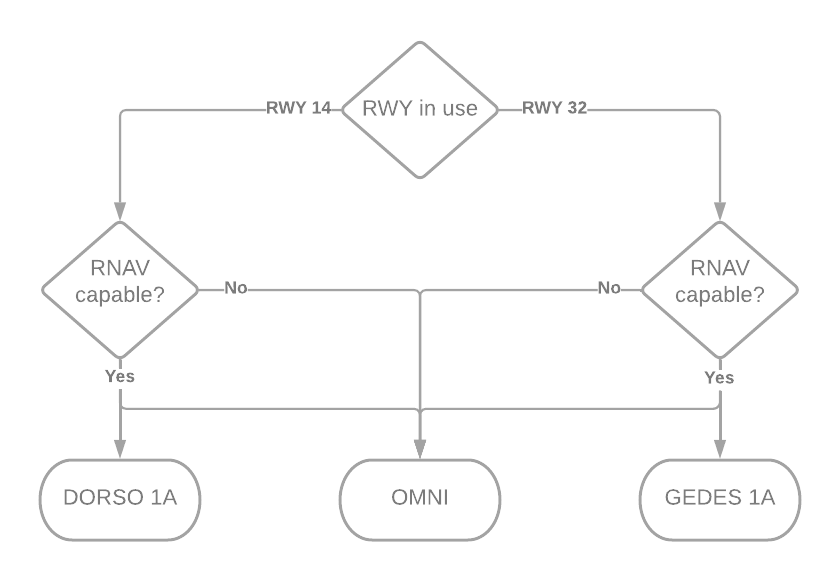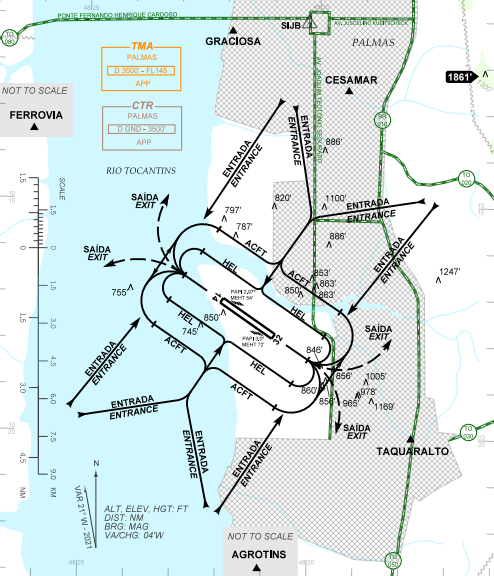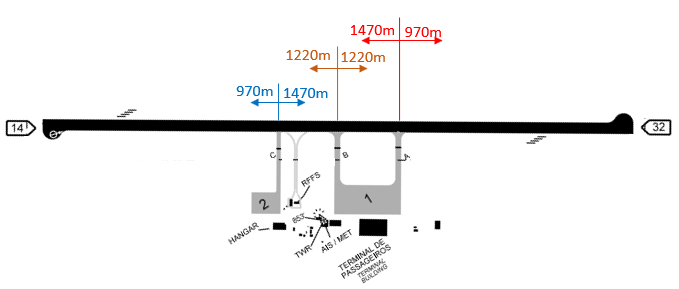Brazil Division
| ICAO | Name | ATC Facilities | SSR | Type of Operation |
|---|---|---|---|---|
| SBPJ | Brigadeiro Lysias Rodrigues | TWR | 0101-0110 | VFR / IFR |
Purpose
This document describes the procedures that must be followed by the Air Traffic Service (ATS) at Palmas Airport. The procedures described here are supplementary to the DECEA procedures.
Scope
Those procedures must be followed and applied by all members that are operating at SBPJ. Especially the ATC, but not exclusive.
Procedural deviations
Exceptional situations, or unusual ones, can necessitate procedural deviations, or complementary procedures, to be added to the following procedures described in this document.
| Facility | Callsign | Frequency | ID |
|---|---|---|---|
| Tower | Palmas Tower | 118.000 | PJ1 |
| Approach Control* | Palmas Control | 119.000 | XD1 |
*AFIS at SBPJ is provided by Palmas APP from 21:00z til 08:59z, daily.
| Facility | Callsign | Frequency | ID |
|---|---|---|---|
| Approach Control | Palmas Control | 119.000 | XD1 |
| Facility | Callsign | Frequency | ID |
|---|---|---|---|
| Center | Brasilia Center | 126.750 | BS1 |
| Center | Amazonico Center | 126.150 | AZ1 |
| Center | Recife Center | 128.8 / 125.4 | RE1 |
| RWY | DIRECTION TO | SID | TRANSITION | AIRWAY | ID |
|---|---|---|---|---|---|
| 14 | NORTH |
DORSO 1A |
OPNUP | Z72 | DOR1A.OP |
| UL576 | |||||
| MASVA | UZ26 | DOR1A.MA | |||
| SOUTH | EGDOD | DOR1A.EG | |||
| Z84 | |||||
| UZ26 | |||||
| LODEK | UL576 | DOR1A.LO | |||
| Anyone | OMNI | - | - | OMNI.14 |
| RWY | DIRECTION TO | SID | TRANSITION | AIRWAY | ID |
|---|---|---|---|---|---|
| 32 | NORTH |
GEDES 1A |
OPNUP | Z72 | GED1A.OP |
| UL576 | |||||
| MASVA | UZ26 | GED1A.MA | |||
| SOUTH | EGDOD | GED1A.EG | |||
| UZ26 | |||||
| Z84 | |||||
| LODEK | UL576 | GED1A.LO | |||
| Anyone | OMNI | - | - | OMNI.32 |
The frequency to call after departure gave to the pilot must follow this priority, depending which ATC is online at that moment:
| # | Facility | Frequency | ID |
|---|---|---|---|
| 1 | SBXD_APP | 119.000 | XD1 |
| 2 | SBBS_ACC | 126.750 | BS1 |
| 3 | Air-to-Air Frequency | 123.450 | - |
NOTE: In case the aircraft remains the traffic pattern, or stays near the airfield, after the departure; the pilot must be instructed to maintain the Palmas Tower frequency after the departure.
According to DECEA, PREFERENTIAL ROUTES is a "Mandatory route, previously established in a collaborative way and published by the CGNA, related to the flight between origin and destination locations or just a segment of the route" (DECEA, ICA 100-22, 2018).
In this way, the ATC must EVER consult the preferential routes BEFORE connecting to the desired position. For this, go to the AISWEB website.
Steps to determine the SID of an aircraft:
- Palmas APP (XD1) is online, ALL SID must be provided by the APP before giving the ATC Clearance;
- Palmas APP is offline, the SID must be provided following this fluxogram.
All VFR departures must be coordinated with the Palmas APP before the takeoff. For this, is necessary to inform to APP:
- Ideal heading to destination;
- Flight Level.
With that information, the Palmas APP will be capable to provide how will be the departure maneuver to the aircraft (if it will be directly on the route; or if it will follow some specif instructions, like flying to "GRACIOSA position" after departure...)
Is important the Palmas TWR know the position definided by the VAC, since it can be used to the departing aircraft:
| POSITION | COORDINATE |
| AGROTINS | 1023S04822W |
| CESAMAR | 1012S04819W |
| FERROVIA | 1012S04833W |
| GRACIOSA | 1011S04821W |
| TAQUARALTO | 1020S04817W |
It isn't common traffic. Before giving the ATC Clearance, the Palmas TWR must ask the crew's intentions. Having that information, ask the Palmas APP (XD1), or the Brasilia ACC (BS1), in case the Palmas APP is offline, the correct SID for the traffic. Then, give the ATC Clearance for the IFR training traffic.
Parking Positions
Normally, the airplanes going to SBPJ must follow those rules about the Parking position:
| FLIGHT TYPE | WINGSPAN (x) | APPRON | POSITION |
|---|---|---|---|
| Airlines | x > 36M | 1 | 1 ou 5 |
| 16M < x < 36M | 2, 3 ou 4 | ||
| x < 16M | 5, 5A, 6 ou 7 | ||
| General Aviation | x > 20M | 1 ou 5 | |
| 12M < x < 20M | 2 | 1 a 3 | |
| x < 12M | 4 a 13 | ||
| Military | Anyone | 1 | 1 ou 5 |
| Helicopter | Anyone | 1L ou 1R |
NOTE: If the pilot request parking at Apron 2 Hangar, it's the aircraft operator's responsibility to guarantee the operational necessities.
Taxiing out
SBPJ has a peculiar characteristic, normally encountered at Brazilian small airfields: the necessity to perform backtrack (when the aircraft joins at the runway via an intermediate part, and taxi to the threshold, occupying the runway during this time) over the runway to take off, or after landing. This characteristic gives down the airport operational capacity, and the air traffic controllers must pay attention to this.
How the Brazilian documentation is a little bit omissive about this topic, we must follow this phraseology:
GLO1829, cleared to join on the runway, report lined up threshold 14.
Helicopters operations
The homologated positions to helicopter parking are 1R and 1L, at Apron 1. For this reason, pay attention when authorizing a non-helicopter to park at those positions. Because, after this, you won't have any helicopter position until the aircraft disconnects from the network. In case the pilot declares intention, the helicopter can authorize to the Apron 2 Hangar (Hangar do Estado).
Clearance to depart from an intermediate position of RWY
Following a DECEA instruction, always that a clearance/suggestion to depart from an intermediate position is given, the ATC must inform the remaining runway length from that position. To this, observe the image below:

Helicopters Operations
The landing and departure of helicopters can be performed on the runway (RWY 14/32); whatever, in case the pilot declares on the frequency that has the condition, he can arrival/depart on the taxiways (A, B, or C; depending on the parking apron). To those cases, the following phraseology must be observed:
(RWY 14/32); whatever, in case the pilot declares on the frequency that has the condition, he can arrival/depart on the taxiways (A, B, or C; depending on the parking apron). To those cases, the following phraseology must be observed:
PTOSH, do you have conditions to approach directly to Charlie taxiway?
This procedure must be done by the helicopters approaching/departing to the North sector. To the helicopters approaching/departing to the South Sector, use the RWY 14/32.
NOTE: it's prohibited to land or depart directly to/from the apron.
TGL at SBPJ
Despite being Palmas TWR responsibility area, the TWR must maintain the Palmas APP informed about the aircraft performing TGL (touch and go landing) at SBPJ; just like, when the aircraft goes to perform a 360º maneuvering on downwind leg or extending the downwind leg.
Traffic Pattern Restrictions
There is no restriction to an arriving/departing aircraft about the Traffic Pattern at SBPJ.
The IFR traffic will be, normally, handoff by the Palmas APP, or by the Brasilia ACC (when the Palmas APP is offline), when on IFR procedure final, and runway insight.
NOTE: the handoff can occur at another point, as long as previously coordinated between the TWR and APP (or ACC, when APP is offline).
Next Controller offline
In case the Palmas APP, or the Brasilia ACC, is offline, the Palmas TWR must contact the aircraft, by the GUARD frequency (121.5), when the IFR Arriving Traffic is starting the IFR procedure.
The IFR aircraft departing must handoff to Palmas APP (XD1) when airborne, or to Brasilia ACC (BS1), in case of Palmas APP is offline.
NOTE: the handoff can occur at another point, as long as previously coordinated between the TWR and APP (or ACC, when APP is offline).
Next controller offline
In case Palmas APP, or Brasilia ACC, is offline, the Palmas TWR must authorize the aircraft to change the frequency when airborne using the following phraseology:
PTOMX, airborne at 06', next controller is offline, frequency change approved.
The VFR traffic, will handoff, normally, by the Palmas APP, or by the Brasilia ACC (when the Palmas APP is offline), at 10NM (10 nautical miles) to SBPJ.
NOTE: the handoff can occur at another point, as long as previously coordinated between the TWR and APP (or ACC, when APP is offline).
Next Controller offline
In case the Palmas APP, or the Brasilia ACC, is offline, the Palmas TWR must contact the aircraft, by the GUARD frequency (121.5), when the VFR Arriving Traffic is at 15NM (15 nautical miles) to SBPJ.
The VFR departing traffic, that won't remain at the traffic pattern, must be handoff to Palmas APP, or Brasilia ACC (when Palmas APP is offline), when airborne.
NOTE: the handoff can occur at another point, as long as previously coordinated between the TWR and APP (or ACC, when APP is offline).
Next controller offline
In case Palmas APP, or Brasilia ACC, is offline, the Palmas TWR must authorize the aircraft to change the frequency when airborne using the following phraseology:
PTOMX, airborne at 06', next controller is offline, frequency change approved.
When the Palmas APP is providing the AFIS at SBPJ, between 21:00z and 08:59z, the procedures below must be followed:
ATC Clearance
Before giving the ATC Clearance, and after giving the meteorological conditions, the Palmas APP must ask the pilot about the runway the crew will use for departure (following the phraseology example below). With this information, the APP will define a SID to the ACFT and so will give the ATC Clearance.
GLO1817, wind 2-3-0º, 7KT, altimeter setting 1-0-1-0, temperature 1-8º, visibility 5km due to light rain over the airfield, time check 4-7'. Confirm which runway do you intend to use for departure.
Traffic information
Due to the service peculiarity, during the AFIS, the SBPJ turns an uncontrolled airfield. So, there is no to speak about taxi, pushback, backtrack, clearance to land, or takeoff AUTHORIZATION. To this end, is EXTREMELY NECESSARY that the Palmas APP give, constantly, updated information about the other aircraft's position; or, if there is no reported traffic around the airport.
Pilot -> Palmas Control, GLO1817, stand 2, starting pushback and startup.
APP -> Palmas Control roger, no reported traffic.
Let's check an example if a traffic is approaching the holding point for departure, and another traffic is on final RWY14:
Pilot -> Palmas Control, PTOMX, approaching hold point RWY14.
APP -> Roger, traffic information, a Boeing 737 on final RWY14, 5NM.
Pilot -> Roger, PTOMX will hold short RWY14
AFIS Start
Like the TWR, the AFIS provided by the Palmas APP will start following the table below:
| VFR | at 10NM to SBPJ |
| IFR | IFR procedure Final |
Parking Position
The parking position definition, IRL, is an Airport Administrator attribution. But here, on virtual, we won't simulate this, even during the AFIS period. Here, the APP will be responsible for defining the parking position. However, it should be noted: TAXI CLEARANCE TO THE AIRCRAFT GO TO THE PARKING POSITION WON'T BE GIVEN.
Pilot -> Palmas Control, PSEYA, on the ground at 0-8'.
APP -> Roger, PSEYA, report vacating the runway, proceeding to stand 5, on apron 1.
Use ever the AISWEB to check the active NOTAM.
NOTE: What must prevail ever is common sense. If the pilot asks not to simulate a NOTAM, and this won't disturb other simmers, this request MUST BE attended! Punctual issues must be reported to our staff team.
SBPJ hasn't ATIS, so, the TWR must provide the meteorological information to all departing aircraft, with the following sort and information:
- runway in use;
- wind direction and intensity, including all significant variations;
- QNH;
- temperature;
- visibility on departure sector, or RVR value of the runway in use; and
- time check
Phraseology:
GLO1817, runway in use 1-4, wind 1-4-0º, 8KT, altimeter setting 1-0-1-2, temperature 2-8º, visibility 8km, time check 5-6'.
| # | Date | Description | Author |
|---|---|---|---|
| - | 06MAR22 | Document creation | Juvenal Gomes (1025243) |
